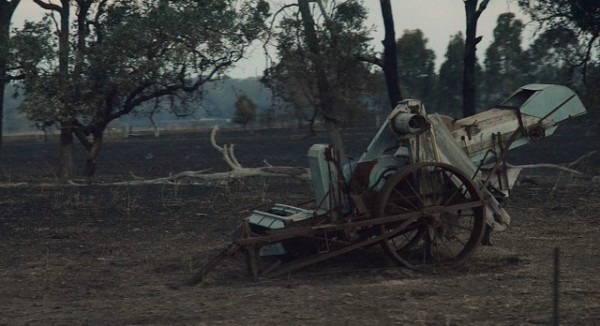The recent bushfires in Western Australia were much more than “bush” fires as they raged through mature crops of wheat, barley, canola and oats, and pastures where many thousands of sheep grazed. The fires claimed four lives and the livelihoods of many farmers as the estimated financial losses of crops and farm animals reached A$60m – a figure expected to rise steeply as the full extent of the damage emerged. One report showed a loss of 15,000 sheep and many cattle.[1] The fires swept eastwards and in South Australia additional fires caused more deaths of people and farm animals and burned through vast areas of mature crops and grazing lands.[2]
In many parts of Australia, “grass fires” consume sheep and cattle forage and, very often, the animals themselves. The term “grass” frequently includes crops but such losses tend to feature more in the agricultural literature than the public media. Further, grass fires usually travel very rapidly across open spaces linking burned and unburned forested areas and farm buildings in patterns that make firefighting extremely difficult. Thus, these most recent fires remind us that as global warming results in more frequent and intense heat waves –and consequent wild fires– their direct impact on food security becomes an increasingly important issue. Food is going up in flames.
The threat has been recognized by the Australian government and Australian farmers are prepared for fire in many ways with well thought out recovery guidelines.[3] Even cool fires may deprive the farmer of stock forage until the vegetation recovers, while very intense fires may destroy both the plants and the seed bank and recovery may require considerable expense and resources. The Australian government funded Grains Research Development Corporation has published guidelines on protecting mature field crops from wildfire damage.[4]
The situation in Australia shows that even though governments and farmers are acutely aware of the possibility of crop and stock losses to wildfires, on the day when threatening conditions coalesce, little can be done except for the people to get out. The government has an additional category for these conditions: “catastrophic”.
Incidents elsewhere in the world show how fires that directly consume food, also destroy food production infrastructure. For example, fires in Washington State, destroyed millions of dollars of food processing plants.[5] Another concern is the haze generated by wildfires, especially persistent ones such as those in Indonesia. In a recent article we see the following statement: “Though the persistent haze and overcast skies aren’t expected to do significant damage to crops, some, particularly corn, could be affected, farmers and agronomists say”.[6] Although we cannot find data that quantify reductions in crop yields attributable to long lasting haze and smoke, it seems likely, possibly through affecting photosynthetic rates. Some tropical fires have devastating direct effects on the food supply, for example, in the state of Roraima, Brazil, 80% of the bean, rice and corn crops were lost to wildfires in 1998.[7] Unhappily, the true costs of tropical wildfires on food are largely unknown.
Other growing impacts of climate disruption on food supplies are well-known, from increasingly severe heat waves and droughts and floods to slowing of yield gains in staple crops[8] and reduction of nutrient quality as the climate warms.[9] We merely point to another little-noted potential barrier to giving humanity a food secure future, one that should be considered and planned for in the multidimensional revolution that likely will be required to avoid catastrophe.[10]
[1] Thompson B. 19 Nov. 2015. Esperance fires: Generations of hard work wiped out. The West Australian. http://yhoo.it/1MHcXGU
[2] 25 Nov. 2015. Two confirmed dead as 45km-wide South Australia bushfire rages. The Guardian. http://bit.ly/1SqZlRH
[3] For example: The State of Victoria Department of Environment and Primary Industries. 2014. Pasture recovery after fire –Quick reference guide. http://bit.ly/1NRQG74
[4] Australian Government Grains Research and Development Corporation. 26 Oct. 2015. Plan of attack needed for harvester fires. http://bit.ly/1jmK34t
[5] Wheat D. 30 Jun. 2015. Wenatchee wildfire losses reach $100 million. Capital Press. http://bit.ly/1Pec3FE
[6] 13 Jul. 2015. Haze shouldn’t cause significant crop damage. AgWeek. http://bit.ly/1PecjED
[7] Cochrane MA. 2010. Tropical Fire Ecology: Climate change, land use and ecosystem dynamics. Springer Science & Business Media. Ch. 1, p.4. http://bit.ly/1MHexsr.
[8] Lobell DB, Tebaldi C. 2014. Getting caught with our plants down: the risks of a global crop yield slowdown from climate trends in the next two decades. Environmental Research Letters 9:10.1088/1748-9326/1089/1087/074003.
[9] Myers SS, et al. 2014. Increasing CO2 threatens human nutrition. DOI: 10.1038/nature13179.
[10] Ehrlich PR, Harte J. 2015. Food security requires a new revolution. International Journal of Environmental Studies. http://dx.doi.org/10.1080/00207233.2015.1067468:1-13.
MAHB-UTS Blogs are a joint venture between the University of Technology Sydney and the Millennium Alliance for Humanity and the Biosphere. Questions should be directed to joan@mahbonline.org
MAHB Blog: https://mahb.stanford.edu/blog/bushfires-food-security/
The views and opinions expressed through the MAHB Website are those of the contributing authors and do not necessarily reflect an official position of the MAHB. The MAHB aims to share a range of perspectives and welcomes the discussions that they prompt.
